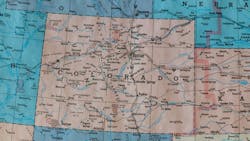New state, federal regulations imperil Colorado’s oil, gas industry
New rules by the US Bureau of Land Management (BLM) and Colorado Energy & Carbon Management Commission (CECMC) will change the way oil and gas companies operate in Colorado.
Federal land use
The BLM Oct. 18 completed a suite of land use-plan updates and habitat conservation strategies that would reduce federal lands available for oil and gas leasing.
BLM also is implementing new Gunnison sage-grouse protections in Mesa and other counties and new protections from energy development for big game habitat in the state.
As part of the plan, BLM would close 543,300 acres in its Grand Junction Field Office’s jurisdiction to future federal oil and gas leasing, leaving 692,300 acres open for leasing. Currently about 1 million acres of federal land is open to drilling in that region. BLM initially proposed to cut available leasing to 237,600 acres.
Of 617,700 acres currently open for oil and gas leasing on federal lands managed by Colorado River Valley Field Office, BLM closed 548,300 acres, leaving 163,000 acres open to leasing.
The new plan allows BLM to resolve litigation related to past planning processes.
“The BLM worked tirelessly with local governments, conservation organizations, industry, Tribal Nations, and other stakeholders over the past two years to find an appropriate balance, which is achieved with the completion of these plans,” BLM Colorado State Director Doug Vilsack said in press release.
BLM also approved amendments to 11 local resource management plans in Colorado and Utah to protect Gunnison sage-grouse habitat on more than 2 million acres of BLM-managed public land and nearly 3 million acres of public below-ground acres, BLM said.
The bird is protected as a threatened species under the federal Endangered Species Act, with just a few thousand remaining. Most of the grouse live in Gunnison basin, but small populations exist in other areas including Piñon Mesa in Mesa County.
BLM says its new plan provides a 1-mile protective buffer around Gunnison sage-grouse habitat and designates a new backcountry conservation area and three new areas of critical environmental concern. It also limits surface disturbance on BLM lands in the bird’s habitat.
BLM also issued an oil and gas management decision to amend resource management plans in Colorado to promote conservation of big-game corridors and other priority big-game habitat on about 6 million surface acres managed by the BLM and 16 million acres of subsurface mineral estate that it manages.
“The final plan requires conservation of seasonal habitats and connectivity in support of Colorado Parks and Wildlife’s big game population objectives,” the federal agency said in its release. “This protects special places for local communities, while allowing responsible development of areas with high potential for oil and gas.”
State standards
Separately, the state of Colorado approved new rules requiring operators to meet strict new standards regarding the impacts of future oil and gas development on public health, the environment, and local communities. The rule starts Dec. 15.
“This action by CECMC builds on our country’s strongest oil and gas standards. It puts into place even better protections for Colorado families and sets a new and higher standard for evaluating and addressing the cumulative impacts of oil and gas operations, especially for people living in the communities most impacted by this sector,” Gov. Jared Polis said in a news release.
Industry representatives warned that the regulations could imperil the oil and gas industry in Colorado.
Under the new state rule, operators must complete a cumulative impacts analysis with each new permit application. The Colorado Department of Public Health and the CECMC must approve the analysis before development could begin.
“Colorado’s oil and natural gas operators have spent the past half-decade in constant rulemakings as state lawmakers have repeatedly moved the goalposts on our regulatory regime,” API Colorado Director Kait Schwartz said in a statement. “As we continue to meet and exceed the state’s ambitious emissions reduction goals while providing Coloradans with the safe and reliable energy they depend on, we strongly suggest the state adopts a more substantive and efficient approach to policymaking.”
About the Author
Cathy Landry
Washington Correspondent
Cathy Landry has worked over 20 years as a journalist, including 17 years as an energy reporter with Platts News Service (now S&P Global) in Washington and London.
She has served as a wire-service reporter, general news and sports reporter for local newspapers and a feature writer for association and company publications.
Cathy has deep public policy experience, having worked 15 years in Washington energy circles.
She earned a master’s degree in government from The Johns Hopkins University and studied newspaper journalism and psychology at Syracuse University.
